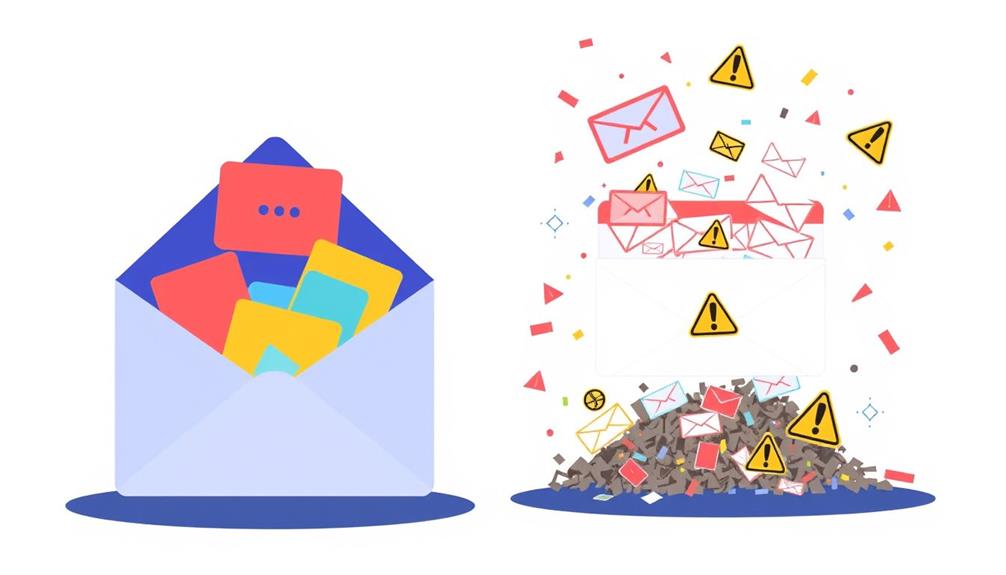Hyper-personalization transforms your email marketing by leveraging big data to create unique, one-to-one experiences. With over 70% of consumers expecting personalized content, this approach greatly boosts engagement and revenue. By analyzing customer behaviors and preferences, you can craft tailored messages that resonate with your audience. Using advanced segmentation techniques and real-time data, you'll not only enhance customer connection but also see increases in conversion rates and loyalty. As you implement these strategies, you'll notice a dramatic improvement in customer satisfaction and retention. Stay tuned to discover how to optimize your hyper-personalization efforts further.
Key Takeaways
- Hyper-personalization leverages big data to create tailored email experiences, enhancing customer engagement and loyalty.
- First-party data is essential for effective hyper-personalization, especially amid privacy regulations and the decline of third-party cookies.
- Predictive analytics anticipates customer needs, allowing for dynamic email strategies that improve conversions and customer satisfaction.
- Advanced segmentation techniques utilize data insights to deliver relevant messaging, increasing the likelihood of customer repurchase.
- Ethical considerations, including transparency and data security, are crucial for maintaining trust while implementing hyper-personalization strategies.
Understanding Hyper-Personalization

Understanding hyper-personalization means diving into a world where tailored experiences redefine customer interactions. Unlike traditional personalization, hyper-personalization utilizes first-party data and machine learning to craft individualized experiences that resonate with customer preferences.
With over 70% of consumers expecting personalization in their digital interactions, it's vital for businesses to adapt their marketing strategies accordingly. This evolution in marketing strategy can be likened to the importance of a well-structured budget that effectively manages resources and aligns with goals.
By leveraging real-time data and advanced analytics, you can deliver contextual content that's relevant and timely. This approach not only enhances user engagement but also boosts customer satisfaction.
When customers feel understood and valued, they're more likely to remain loyal, contributing to improved customer retention rates. Statistics show that nearly 75% of consumers prefer brands that offer personalized experiences, underscoring the necessity of hyper-personalization in today's competitive landscape.
Additionally, businesses that implement hyper-personalization strategies often witness a revenue increase of 10-15%. By focusing on these tailored experiences, you'll not only meet customer expectations but also drive sales and foster deeper connections with your audience.
Embracing hyper-personalization is essential for thriving in the digital age.
The Role of Big Data

In the world of hyper-personalization, your data collection strategies play a vital role in shaping customer insights.
By harnessing big data, you can tailor your email campaigns to reflect individual preferences and behaviors, ensuring that your messaging resonates with your audience. This not only enhances your messaging but also boosts customer engagement and loyalty.
Effective email marketing strategies, such as segmentation of audience, can help you reach the right individuals with the right content at the right time.
Data Collection Strategies
Data collection strategies are essential for achieving hyper-personalization in email marketing. To create truly personalized email experiences, you need to gather both structured and unstructured data from various sources. This includes customer interactions, transaction histories, and social media insights.
Utilizing first-party data is particularly important, especially with stricter privacy regulations and the discontinuation of third-party cookies looming in 2024. Additionally, as the demand for roles such as AI Ethicist Jobs increases, understanding the ethical implications of data collection becomes critical for maintaining public trust.
By implementing advanced segmentation techniques like demographic targeting and customer journey mapping, you can pinpoint user preferences and behaviors with precision. Real-time data access is essential, allowing you to analyze customer insights and adapt your strategies quickly.
This agility enhances your personalization efforts, making your emails more relevant. A unified source of truth for customer data is also important for seamless omnichannel engagement. When your data is consistent across all platforms, your personalized email experiences can resonate more effectively.
Ultimately, effective data collection strategies empower you to create tailored content that speaks directly to your audience, driving engagement and loyalty. By focusing on these strategies, you can elevate your email marketing game and achieve the hyper-personalization your customers crave.
Insights for Personalization
Harnessing big data transforms your approach to hyper-personalization in email marketing. By analyzing vast amounts of structured and unstructured information, you can gain invaluable insights into customer interactions and transaction histories. This data is essential for crafting tailored email experiences that resonate with your audience.
For instance, understanding customer investment preferences can help you create targeted campaigns that align with their financial goals.
Utilizing advanced analytics and machine learning techniques, you can uncover patterns and predict customer behaviors, allowing for more effective personalized marketing strategies. Real-time data access is equally significant, as it enables you to create contextual and relevant content that engages users and boosts satisfaction through timely messaging.
As privacy regulations tighten, leveraging first-party data becomes indispensable. This data, derived directly from customer interactions, empowers you to develop bespoke email experiences without relying on third-party cookies.
Companies that effectively utilize big data for hyper-personalization often see significant revenue increases, with studies indicating an average growth of 10-15% linked to personalized marketing efforts.
Incorporating big data into your email marketing strategy not only enhances customer engagement but also drives business success. Embrace the power of insights for personalization, and watch your email campaigns thrive.
Transforming Data Into Insights

To truly understand your customers, you need to master data interpretation techniques that reveal hidden patterns.
By leveraging insights from evaluating Bitcoin IRA suitability, you can better anticipate customer behavior and generate actionable insights that drive your email campaigns.
With predictive analytics, you can anticipate customer behavior and generate actionable insights that drive your email campaigns.
Data Interpretation Techniques
Transforming raw information into actionable insights is essential for effective email marketing. By leveraging advanced data analytics techniques, you can interpret vast amounts of behavioral data and create personalized content that truly resonates with your audience.
This approach reflects a broader understanding of user engagement strategies, as emphasized by digital engagement insights. Using machine learning algorithms, you'll uncover patterns and predict customer behaviors, leading to enhanced email personalization.
Here are three key techniques to evaluate:
- Granular segmentation: Break down your audience based on diverse data points, like browsing history and purchase patterns, to tailor your messages more effectively.
- Real-time data analysis: Access current customer interactions to adapt your email strategies swiftly, ensuring relevance and timeliness.
- Predictive analytics: Anticipate customer needs, enabling you to craft more relevant email content that drives engagement and boosts conversion rates.
Predictive Analytics Benefits
Predictive analytics is a powerful tool that can greatly enhance your email marketing strategy. By leveraging historical data and machine learning, you can forecast customer behaviors and preferences, allowing for more personalized marketing efforts. This means you can craft tailored communications that resonate with your audience, ultimately boosting engagement rates.
Furthermore, top platforms for online earning can provide additional insights into customer preferences that can further refine your email campaigns.
When you utilize predictive analytics, you're not just guessing what your customers want; you're anticipating their needs. This approach can lead to a 50% reduction in acquisition costs and markedly improved conversion rates. Approximately 77% of companies using predictive analytics report increased customer satisfaction and loyalty, thanks to the relevance of their email campaigns.
Additionally, predictive models analyze vast amounts of data to identify patterns, optimizing your campaigns and potentially increasing revenue by 10-15%. With nearly 90% of consumers finding personalized marketing appealing, it's clear that predictive analytics plays an essential role in creating relevant experiences that drive customer retention and encourage repeat purchases.
Embracing this technology can transform your email marketing from a one-size-fits-all approach into a dynamic, engaging strategy that truly connects with your audience.
Actionable Insights Generation
Leveraging advanced analytics techniques like machine learning and AI can turn massive amounts of data into actionable insights that drive hyper-personalization in email marketing. By analyzing big data from various sources, you can gain a clearer understanding of your customers' preferences and behaviors. This helps you craft personalized email content that resonates with them.
Additionally, just as a raw food diet for pets can enhance health through personalized nutrition, your email strategy can benefit from tailored insights based on individual customer data.
Consider these key benefits of actionable insights generation:
- Enhanced Customer Interactions: Analyze transaction histories and social media activity to uncover granular preferences.
- Real-time Data Analysis: Swiftly adapt your campaigns based on changing customer behaviors, improving engagement rates.
- Targeted Messaging: Identify customer segments for tailored messaging that aligns with individual needs.
Using predictive analytics, you can anticipate customer behaviors, allowing you to send timely and relevant emails. This not only fosters deeper connections but also drives repeat purchases.
Benefits of Hyper-Personalization

Hyper-personalization in email marketing offers numerous benefits that can greatly impact your business's success. By leveraging data analytics, you can create personalized experiences that considerably enhance customer engagement.
In fact, 86% of companies report measurable business results from their hyper-personalization efforts. When you focus on tailored content, you're likely to see higher conversion rates, with 78% of consumers more inclined to repurchase from brands offering such content.
Additionally, utilizing emotional triggers in your messaging can deepen customer connection and enhance engagement, as seen in powerful persuasive words.
Moreover, utilizing hyper-personalization strategies can lead to a revenue increase of 10-15% on average for your business. This approach not only boosts immediate sales but also strengthens customer retention, as nearly 75% of consumers prefer brands that provide personalized experiences.
Effective hyper-personalization can also reduce customer acquisition costs by up to 50%, allowing you to allocate resources more efficiently.
Furthermore, your brand visibility improves through tailored engagement efforts, ensuring your messages resonate with your audience. By embracing hyper-personalization, you're positioning your business for long-term success, driving both customer loyalty and improved overall performance.
Ethical Considerations and Privacy

Maneuvering the landscape of email marketing requires balancing personalization with user privacy. As you immerse yourself in hyper-personalization strategies, consider the ethical implications of your data practices. With increasing scrutiny on third-party cookies, it's crucial to prioritize first-party customer data and comply with regulations like GDPR.
Just like how juice extraction techniques vary for different fruits, the methods of gathering and using customer data must be tailored to respect individual preferences.
To maintain customer privacy and build trust with consumers, focus on:
- Transparency in data collection: Clearly communicate how you collect and use data.
- Consent for data processing: Always obtain explicit permission before using customer data.
- Robust security measures: Protect sensitive information to prevent breaches and maintain customer confidence.
Emphasizing ethical data usage is more than just compliance; it's about creating genuine connections with your audience. According to research, 62% of consumers won't stay loyal to brands that deliver un-personalized experiences.
Implementing Effective Strategies

Building on the importance of ethical data practices, implementing effective hyper-personalization strategies in email marketing demands a keen understanding of your audience.
Start by leveraging first-party data to gain insights into customer preferences and behaviors. With 70% of consumers expecting personalized interactions, you need to create tailored content that resonates with specific audience segments.
Utilizing advanced segmentation techniques can greatly enhance your email engagement. In fact, 86% of companies report measurable results from personalized content.
Incorporate predictive analytics to anticipate customer needs, as nearly 50% of brands note increased conversions from aligning marketing initiatives with user behavior.
Real-time analytics platforms are essential for adapting your campaigns instantly, ensuring your communications remain relevant and timely.
This fosters higher engagement rates, which are vital in today's competitive landscape.
Future Trends in Hyper-Personalization

The future of email marketing is poised to be shaped by an increasing demand for hyper-personalized experiences that resonate with individual consumers. As businesses adapt to evolving consumer expectations, several trends will emerge:
- Generative AI will enhance connected customer experiences, streamlining hyper-personalization efforts.
- Real-time analytics will become essential, enabling businesses to adapt quickly to changing consumer preferences.
- Continuous investment in personalization technologies will redefine customer engagement, ensuring tailored interactions.
With 86% of companies reporting measurable results from hyper-personalization strategies, it's clear that leveraging big data will be critical for success.
Consumers aren't just interested in personalized marketing; 90% find it appealing. This means you must focus on creating tailored communications that drive engagement and meet customer experiences head-on.
To stay competitive, embrace generative AI and real-time analytics as integral parts of your email marketing strategy.
By doing so, you'll not only meet consumer expectations but exceed them, ultimately enhancing customer loyalty and conversion rates.
The era of hyper-personalization is here, and those who adapt will thrive in this data-driven landscape.
Frequently Asked Questions
What Is Hyperpersonalization in Email?
Hyperpersonalization in email means tailoring content specifically to you, based on your preferences and behaviors. It creates a unique experience, increasing engagement and making you feel valued, which can lead to more meaningful interactions.
What Is an Example of Hyper-Personalization Approach?
Imagine receiving tailored product recommendations based on your recent browsing and past purchases. This approach not only boosts engagement but also greatly increases conversion rates, making your shopping experience more enjoyable and personalized.
How to Do Hyper-Personalization?
To do hyper-personalization, gather customer data, analyze preferences, and segment your audience. Craft tailored messages that resonate with each group, and continually optimize your strategy based on real-time feedback and evolving customer behaviors.
What Is the Difference Between Hyper-Personalization and Personalization?
Imagine walking into a café where the barista remembers your name and favorite drink. That's hyper-personalization. It's tailored to your preferences, unlike standard personalization, which feels more like a generic order taken from a menu.
Conclusion
As you navigate the vast ocean of digital communication, think of hyper-personalization as your guiding star. By harnessing the wind of big data, you can steer your email campaigns toward meaningful connections that resonate with each recipient. Just as a skilled sailor knows the currents, you'll learn to transform data into insights that not only delight your audience but also respect their privacy. Embrace this journey, and watch your efforts bloom like flowers in a well-tended garden.









